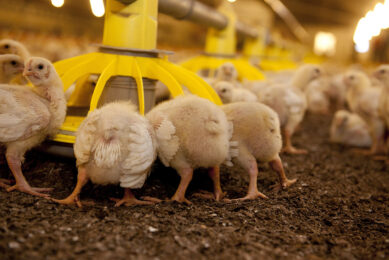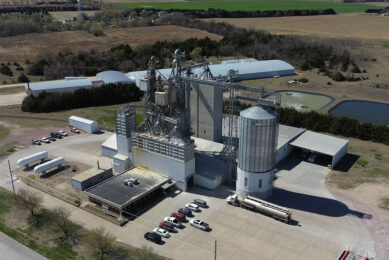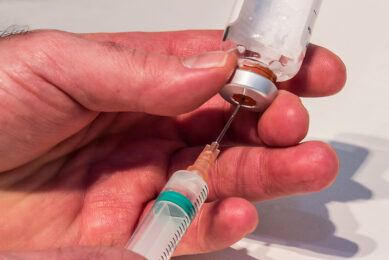Antimicrobial use: The outlook to 2030
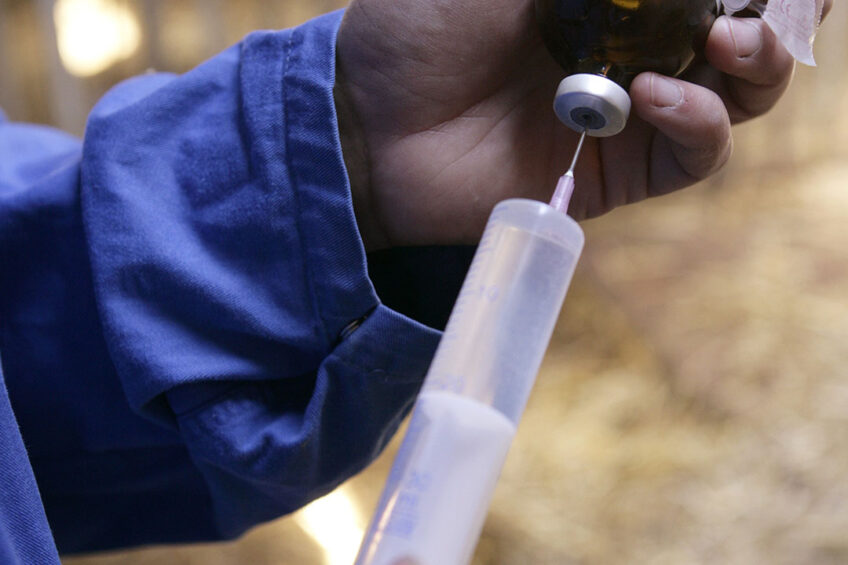
This article looks at how future levels of resistance to antibiotics can be extrapolated from today’s usage patterns, and how stewardship can be best managed.
Tracking current levels of antimicrobial use in livestock farming is a critical step in estimating how much will be used in future – and may help to spur stewardship efforts (changes in how we use antibiotics) so that resistance (AMR) to antibiotics is minimised going forward.
Current and future trends
It’s still a global reality that antibiotics of many important classes in human medicine are still given to livestock animals not only for treating diagnosed illnesses, but also to prevent disease and for growth promotion. This varies by livestock species and country.
In late 2020, a group of scientists published a current and future look at the situation. The group included Dr Thomas Van Boeckel, who holds positions at the Institute for Environmental Decisions at ETH Zürich in Switzerland and the Centre for Disease Dynamics Economics and Policy in India, along with colleagues from the Université Libre de Bruxelles and the Fonds National de la Recherche Scientifique in Belgium, and the Food and Agriculture Organization of the United Nations (UN FAO).
They collected data on antimicrobial sales for chicken, cattle and pig production in 41 countries and then projected global antimicrobial consumption to 2030. They estimated that globally, sales would rise on all continents, in total rising by 11.5% from 2017 to 2030. However, this is a lower estimate than previous estimates because of recent reductions in antimicrobial use in many countries, particularly in China where most of the world’s antibiotics for livestock are used (Figure 1). At this point however, Van Boeckel says we know very little about trends in use and the extent of AMR in fish production systems. He believes the aquaculture sector deserves more attention in terms of tracking antibiotic use not least because it’s growing so fast compared to production levels of terrestrial livestock species
Figure 1 – Antimicrobial consumption per country in 2017 and 2030. The size of the circles corresponds to the amounts of antimicrobials used. Dark red circles correspond to the amounts used in 2017, and the outer blue ring corresponds to the projected increase in consumption in 2030.
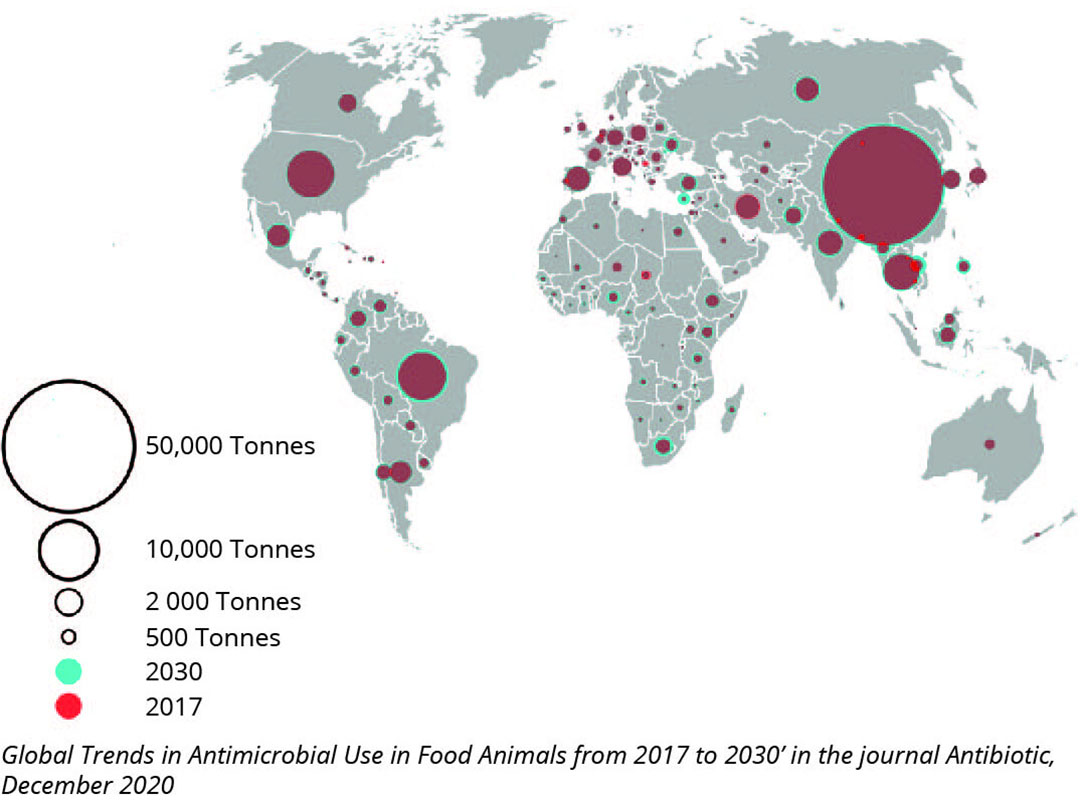
Lending a helping hand
There is also a lack of complete country data, as not all countries share data (or are able to share data) on AM use in livestock production. What can be done to get every country to track AM use and share information? Van Boeckel concurs that the problem is serious enough and agrees that it would be a good idea for developed countries to give funding to developing countries for this purpose. “In my opinion, even if high-income countries are completely clinical about the notion of other less-developed countries, it would still be in their interest to help countries where surveillance is not yet in place and effective,” he says. “Ultimately they would be protecting themselves by helping others.”
He adds, however, that there are already some ongoing initiatives that support low- and middle-income countries to generate, share and use data to improve antimicrobial use and encourage investment in AMR such as the Fleming Fund, “but a global scale-up of these initiatives would be welcome.”
Scenarios that could reduce AM use
In March 2021, a paper was published on how use of antibiotics – and therefore AMR – can be reduced on a global scale. The analysis was conducted by scientists at Johns Hopkins University and American University in the US.
Using new modelling of global livestock production and trade between 18 countries and aggregated world regions, these scientists were able to see a new level of interconnections between countries and the use of antimicrobials in food animal production. They looked at 3 scenarios that might decrease the use of antimicrobials, which would also therefore help reduce the growing global AMR problem.
These scenarios are:
- globally increasing fees to use antimicrobials,
- a global ban of meat imports from Brazil, and
- a decrease in China’s meat consumption.
In the first scenario, it was found that a user fee that increases the price of antimicrobials by 50% globally would lead to a 33% reduction in global antimicrobial use. “However, participation of developing and emerging countries in the coordination scheme is jeopardised,” the scientists explain in their paper, “since they become less competitive for meat sales compared to developed countries.”
Secondly, a global ban on meat imports from Brazil would only lead former importers to turn to other countries for meat, such as the US.
“Lastly, meeting China’s medium-term lower meat consumption target would not affect global antimicrobial use, but could increase China’s antimicrobial use by 11%,” the scientists conclude.
They also believe trade to be an important factor in the reaching of policy goals related to antibiotic use, and that global cooperation is required to align the incentives of all countries toward tackling AMR.
Stewardship efforts
In terms of how antibiotic stewardship policies should be shaped in livestock production, another analysis published in 2020 outlines the limits of existing regulation of antibiotics use, but also opportunities for improved surveillance, stewardship and advocacy.
The authors, based in the US at Lurie Children’s Hospital, Northwestern University, the US Public Interest Research Group and the US Department of State, recognise that there has been some successful implementation of stewardship strategies in some countries, including banning uses for disease prevention, benchmarking antibiotic use and setting national reduction targets.
However, “significant challenges in surveillance and regulatory oversight remain to prevent the overuse of antibiotics in food production.”
Among other solutions, they believe “consumers remain a potent force via market pressure on grocery stores, restaurants, suppliers and farmers,” and that “improved, verified labelling is important for informing consumer choices.”
Van Boeckel only slightly agrees with this conclusion. “It would be good to check with someone who works on consumer behaviour,” he says, “but my impression is that it will only work for the small fraction of people concerned and who aware about the problems that AMR can cause in food. To encourage a broader reduction of AMU we need to reach the larger fraction of people, this could potentially be done through [higher animal food product] prices. In a paper in the journal Science in 2017, I and my colleagues suggested introducing a tax on veterinary antimicrobials that could help do that, and fund improvements in farm hygiene.”
Multi-faceted approach
Better farm hygiene is certainly important in reducing the need for antibiotics in livestock production, but there are many other stewardship approaches. They include preventative-medicine programmes that reduce disease incidence, improving the environmental conditions for livestock animal to prevent/reduce stress and the eradication of specific livestock diseases. There are also the ideas of optimising feed nutrition to enhance animals’ natural immunity and breeding for more disease-resistant lines and the development of alternatives to using antibiotics for growth promotion and to prevent disease.
Van Boeckel thinks more research is needed to discriminate between the efficacy and public health impact of different alternatives.
“Antibiotics ought to be replaced, but to me it is still unclear what the best alternative will be, or more likely, what combinations,” he says. “One example of research ongoing on this topic is the ‘Horizon 2020 project AVANT’ of which I am a part.” AVANT is aimed at developing alternatives to antimicrobials for the management of bacterial infections in pigs, especially diarrhoea during the weaning period, as this represents the major use of antimicrobials in European livestock production.
References are available on request.





